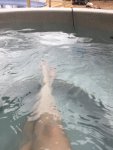- Jul 21, 2013
- 60,151
- Pool Size
- 35000
- Surface
- Plaster
- Chlorine
- Salt Water Generator
- SWG Type
- Pentair Intellichlor IC-60
Having the details of the body of water you are maintaining would help in answering your questions. Please create your signature with details of your spa.
Is it outdoors?
Is it covered when not in use?
Is it outdoors?
Is it covered when not in use?



